When Skeptics Get Sex Wrong: Debunking the Debunker
The case of Dr. Steven Novella demonstrates that even skepticism’s finest are not impervious to putting ideology over reality.
Reality’s Last Stand is a reader-supported publication. Please consider becoming a paying subscriber or making a one-time or recurring donation to show your support.
This post originally appeared on the author’s website The Curious Case of Science.
This year, I attended the annual CSICon conference, hosted by the wonderful skeptical organization Center for Inquiry. Among the star-filled lineup of amazing speakers were Professor Jerry Coyne and Dr Steven Novella, who both gave talks about the science of biological sex.
Following CSICon, both Novella and Coyne wrote blogposts about the others’ talk, and I decided to make a short Facebook post giving my own brief opinion about the matter. It didn’t take long before Dr Novella appeared on my post to argue the issue, and what followed was a cascade of scientific blunders, logical fallacies, and a critical thinking deficit that one wouldn’t normally expect to see from such an esteemed member of the skeptical community.
With Brandolini’s bullshit asymmetry principle in full effect (Brandolini may have been off by an order of magnitude or two), the comments section just wasn’t cutting it. So I wrote up a response and offered Dr Novella the opportunity to publish it on one of his blogs. Not surprisingly, Dr Novella ghosted me so hard that one would be excused for thinking he started believing in the undead!
The picture below is from the acknowledgments section of my book that I mentioned in the Facebook post.
It’s there to demonstrate two things: One, that when I first took an interest in this topic a few years ago, I was heavily biased towards Dr Novella’s position (I’d been arguing the “spectrum” position at that time). And two, despite his ideological blind spot here, Dr Novella is still a champion of science and reason, and it’s important not to throw the baby out with the bath water. But, as we’ll see, this is some particularly nasty bath water, so let’s get punk rock and dive in.
After a few back and forth comments between us, Dr Novella returned with a string of particularly bad arguments, beginning with the one above. As readers can see from the (previous) comment below, curiously, Dr Novella references the American College of Pediatrics, the National Institute of Health, and the Journal of Applied Physiology to define biological sex. He ended with a lament that he wasn’t “seeing a consensus that sex is defined as gametes.” Considering that Dr Novella looked everywhere he could other than high impact biology journals, we shouldn’t be terribly surprised that he didn’t fine one.
But back to his original comment where he claimed (without evidence) that I dismissed his examples. In fact, I’d done no such thing. My response to the cherry-picked examples he used to try and define biological sex was:
You didn’t cite your sources, so I can’t assess their veracity, context, evidentiary support, or qualifications. However, as Coyne points out, we’ve been using gametes to define sex for a very long time. And for good reason. These new definitions followed from the culture war, not empirical research.
I then provided Dr Novella with five definitions of biological sex which I drew from primary sources, informing him that, “There’s no evidence that [the binary model] isn’t the generally accepted definition among biologists. On the contrary, biologists agree that sex is binary…”
I had also provided Dr Novella with a definition of sex which was drawn from the primary literature.
Clearly I didn’t just dismiss his examples. I said I couldn’t vet them. But now let’s dismiss them.
Obviously, Dr Novella’s definitions don’t represent the consensus of biologists. Indeed, they weren’t even written by biologists, and they certainly didn’t come from biology journals. The American College of Pediatricians cite neither developmental nor evolutionary biology primary literature (Novella has pivoted to claiming (without evidence) that his perspective is in line with developmental biologists’s; that he couldn’t cite a single one completely undermines this claim), and it was written by MDs, not biologists. In fact, his reference here links back to a book that aimed not to gather a consensus statement from biologists about the definition of biological sex, but to explore the biology of sex differences between males and females to further advance science and medicine.
Likewise, the NIH cite falls into the same dubious category, not to mention, as another commenter pointed out, the NIH quote “is a page set up by an intern… it doesn’t speak on behalf of the NIH, it is poorly researched, cited intersex rates that were debunked two decades ago…was from a panel on measuring variables related to sex… and cited a graphic full of errors by someone with no background in science.“ The NIH cite links to a page which makes it clear that the definition:
did not come from biologists,
is not representative of biological research, and
was intended to “evaluate existing measures of sex, gender identity, and sexual orientation and recommend specific measures to be used to standardize federal data collection efforts.”
But even if the NIH declared that sex wasn’t binary in an official statement, that wouldn’t magically make sex a complex multidimensional phenomenon as Novella insists. That would have to be established in the scientific literature, and it would have to be more robust than the binary model that is ubiquitous across biological sciences, which is something that simply hasn’t been done.
Dr Novella’s reference to the Journal of Applied Physiology defines sex as “The noun sex includes the structural, functional, and behavioral characteristics of living things determined by sex chromosomes.” This statement was written by a nurse researcher and a Professor of Physiology, neither of which specialize in biology, which may be why these definitions of biological sex don’t reconcile across organisms other than humans.
Anyway, any scientific rigor this statement may have is sufficiently confuted by a statement from the Endocrine Society on the importance of understanding the sex binary, which I previously linked for Dr Novella in the comments. Dr Novella should’ve been more skeptical of his own sources, but if you’re thinking “how could he be so credulous?,” strap in because his lack of critical thinking gets far worse.
What’s most telling here is that, despite Dr Novella’s status as a first rate skeptic—never mind his evidence-free claim that his position reflects the views of developmental biologists—the best evidence he provided was a few random quotes that weren’t published by biologists and don’t reflect any biological science.
Next, Dr Novella tries to claim that an evolutionary perspective of biological sex is too narrow. “Did you notice that your examples are all evolutionary? Do you not realize that this is a narrow perspective, which is part of my point?”
In fact, I had noticed. Evolutionary biologists are subject matter experts here, which is why I cited them. Moreover, evolutionary biology is about as robust as biology gets. As the evolutionary biologist Theodosius Dobzhansky famously noted, “Nothing in biology makes sense except in the light of evolution.” Saying an evolutionary perspective is narrow—in contrast to a narrative that applies to one extant species—really betrays Dr Novella’s prejudices. I’m not sure how he came to the conclusion that developmental biology, a subset of evolutionary biology, is less narrow than the broader category, but biology teachers have been teaching the binary model since long before the ideological subversion of biology began. For example, below is an assignment from 12 years ago published in The American Biology Teacher, the leading journal for life science pedogogy.
It’s based on the same, long-held definition of sex. Of the competing definitions here, one of them applies to all animals and vascular plants; one of them can be applied only to humans. Readers can decide which one is “narrow.”
Dr Novella then gives us a glimpse into what he meant by the evolutionary model being “a narrow perspective.” Here, he attempts to advance the argument that the perspective of developmental biologists differs from that of evolutionary biologists.
“Kevin Folta, how [sic] has a PhD in biology, disagrees with you and Coyne - and he pointed out explicitly that the perspective of a developmental biologist is different than an evolutionary biologist.”
Unfortunately for Dr Novella’s argument, Dr Folta doesn’t get to decide—without evidence—what the perspective of developmental biologists is. In fact, Dr Emma Hilton, one of the most qualified developmental biologists to speak on the subject, adamantly disagrees with Dr Folta (who isn’t a developmental biologist), and she isn’t alone. Far from it, as this developmental biology textbook and others attest to. Importantly, the perspective of developmental biologists doesn’t differ from that of evolutionary biologists, which is something Drs Novella and Folta should both know. We don’t see these differences in empirical research. We only see it in the culture wars, which good skeptics would do right to notice.
“And for the record, I have a masters in human physiology as well as an MD, and it is not accurate to say I do not have a background in biology.”
I’m at a loss as to why Dr Novella kept saying this, as I never claimed he didn’t. He definitely has background in biology and no doubt he probably uses principles of biology every day. But he is neither an expert nor a biologist. I studied computer applications in college and I use a computer every day. That doesn’t make me an expert software engineer. Dr Novella specializes in how to take care of the human body, specifically the nervous system. That doesn’t make him an expert in reproductive biology, and from his musings on the matter it doesn’t appear that he understands how biological sex is about all of the 10 million extant species on earth.
Now, I couldn’t find the discussion in the SGU transcripts, but in a fairly recent episode (within the last year I’d say), Dr Novella said something to the effect of “even in neuroscience I have to ask other neuroscientists questions if it’s about something that’s outside of my narrow field of neuroscientific expertise.” He said something similar in episode 65. “But what this email reminded me of is that no matter what we talk about, unless I happen to be talking about my very narrow subspecialty within neurology, there’s guaranteed to be someone out there who knows more about the topic than we do.” I’m amazed that he can say these things in one breath, and claim to be an expert in biology in the next.
Continuing, Dr Novella takes issue with the fact that I hadn’t established a consensus among biologists on what the definition of sex is. “You have not established there is a consensus among biologists - you just dismiss the biologists who disagree with you.”
This is probably his most interesting point, albeit it’s a bit dishonest (recall, I never dismissed his examples, and he didn’t cite any biologists). The question that I find interesting is, why isn’t there a consensus statement among biologists on this topic? Clearly biologists think sex is binary (examples can be found here, here, here, here, here, here, and elsewhere), so I suppose without a bona fide consensus statement, the only way to “prove” that’s the consensus view would be by being scientific about it and failing to prove biologists think sex is multidimensional, which Dr Novella has done by citing interns and pediatric journals as the best evidence to support his case.
Another interesting (and telling) component here is the number of biologists who are silent on the topic. That alone rings my skeptical alarm bells. Why would biologists be afraid to say sex is not binary in the current social climate? Well, obviously they wouldn’t be on account of the current culture wars on sex and gender. So why aren’t there more of them? Why aren’t all of them saying that? Can we assume it’s because they’re too scared of being canceled or labeled a transphobe, like teachers, academics, clinicians, social workers, civil servants, managers in organizations, many journalists, people in the arts, media, and publishing companies are? Even philosophers are afraid to publicly take the binary position, despite that that’s what they believe. It seems pretty obvious to me that if sex weren’t binary, we’d have a consensus statement saying as much. Instead, we have to search the primary literature to see how biologists actually define biological sex, which is something we saw Dr Novella avoided like the plague.
Dr Novella then claims that “Regarding Coyne’s neuroscience arguments - no, this is not about competing definitions of sex.”
His original post is titled “The Science of Biological Sex” in which he boldly cites no biological science, and argues that sex isn’t binary. Call me naive, but it seems a rather odd claim to make that an article about what biological sex is (and isn’t) where he discusses competing definitions of sex is not about competing definitions of sex.
But let’s cover a few things his article got wrong. He claimed (while citing long debunked nonsense) that intersex conditions occur in ~2 percent of births. This is objectively false. Intersex conditions occur somewhere between 1:200-1:300. Genital ambiguity is even less common, with a reported frequency in the range of 1:2000-1:4500.
He claimed, again without any evidence (astute readers might've noticed a pattern by now), that the “notion that sex is not strictly binary is not even scientifically controversial” when in fact (1) it’s the binary model that most biologists use and have used for decades (on top of the other primary sources I provided, here and here are some random examples from biology textbooks) and (2) this topic is the subject of ongoing debates from science and philosophy to sociology and politics. So, his evidence-free claim that it’s not controversial is false. As we saw above, he also cherry-picked random definitions written by non-experts, he didn’t cite any primary sources from biologists to support his understanding of biological sex, he got bimodal distributions completely wrong (and then on my post he made the post hoc argument that “the bimodal model was just a metaphor” even though it clearly wasn’t), amongst a host of other errors that Lewis, Coyne, Wright, myself and others have pointed out ad nauseam.
He also claimed that the biologist James Lyons-Weiler is wrong to say sex is determined by chromosomes, and then falsely stated that Lyons-Weiler said sex is “entirely determined by karyotype.” Lyons-Weiler said no such thing. He said sex is determined by chromosomes (he didn’t say it’s entirely determined by chromosomes), which is completely true. They’re literally called sex determinants because of their role in determining sex. Determinant has a very specific meaning in developmental biology which Dr Novella seems to have missed (more on this later). He then went on to claim that sex isn’t binary because the things he thinks don’t determine sex (karyotype) are sex. To Dr Novella, multiple karyotypes = multiple sexes, which isn’t supported by biological science. So either he’s ignorant about what sex determinants are, he’s being dishonest, or he’s doing the thing he claimed (without any evidence) Coyne did: Playing word games, while pretending it’s everyone else engaging in semantics.
Next, Dr Novella makes the baseless claim that I then “double down by assertion alone the core fallacy of Coyne and others - defining sex as gametes alone.”
I don’t think providing multiple citations to primary literature written by actual experts in relevant fields qualifies as “doubling down by assertion alone,” nor that defining sex by gametes is fallacious. Ironically, here Dr Novella is claiming, by assertion alone, that that’s what I did. I’ll quote the famous biologist R.A. Fisher to nail down my point: “No practical biologist interested in sexual reproduction would be led to work out the detailed consequences experienced by organisms having three or more sexes; yet what else should he do if he wishes to understand why the sexes are, in fact, always two?”
Now to one of Dr Novella’s more egregious blunders that underscores his distance from biological nomenclature. “Again, this is a silly semantic game. Saying that chromosomes determine sex but are not sex is just a non sequitur.”
It’s neither semantics nor a non sequitur, but, rather, Dr Novella’s failure to understand biological terminology. In developmental biology, “determine” describes the mechanisms that regulate the development of something, in this case the sex development pathway. Like sex, the word determine has a very specific meaning in developmental biology, which is something he should know, given that he claims his view is representative of developmental biology. One developmental biology textbook defines sex determination as “the genetic and developmental process by which an organism’s sex is specified.” Or, as another Facebook commenter pointed out, sex determinants are the “general, top level thing that typically is responsible for starting the sex development cascade.” Conversely, sex is defined by the phenotype that produces one of two gametes, thus sex determinants cannot be the thing they are determining. Dr Novella, therefore, is making a categorical error in conflating sex with sex determinant. Zachary Elliott has written an excellent piece on this distinction that I encourage interested readers to check out.
Dr Novella then claims that “there are not only two endpoints. There is a range of endpoints depending on lots of developmental variables.”
There are exactly two endpoints: ova and sperm. Developmental variables (we might say determinants such as genes) lead to one or the other, and rarely both. What Dr Novella is doing here is conflating upstream mechanisms and downstream effects with the thing in the middle (see picture below). He also appears to be conflating sex with gender, and although there are a plurality of genders, there are still only two sexes.

To support his claim that there are multiple endpoints to sex determination, he used the disorder of sexual development CAIS as an example.
To be sure, CAIS (Complete Androgen Insensitivity Syndrome) is probably the strongest case anyone on the “spectrum” side of the argument can make, since they can be considered biologically male but medically female. Nevertheless, people with CAIS are not a third sex (and see here), and they’ll tell you the same thing themselves. If we’re to believe Dr Novella that CAIS presents us with an alternative endpoint, he should also explain what that endpoint is. “It’s messy” is neither scientific nor explanatory.
Moving on, Dr Novella then states that “The undeniable fact is that sexual dimorphism in humans, the full suite of characteristics that vary according to biological sex, includes genetics, hormones, gametes, anatomy, physiology, and neurological function.”
No one is arguing that humans are not sexually dimorphic, nor that the “characteristics that vary according to biological sex [don’t] include genetics, hormones, gametes…” etc. The only argument I advanced was that biological sex is binary. Maybe that’s the disagreement here. I suspect that maybe Dr Novella is unaware of what is meant when a biologist says sex is binary. I’ll let the PhD biologist Colin Wright explain:
When biologists say sex is binary, we’re not saying that every human who has ever existed or ever could potentially exist is unambiguously classifiable as 100% either male or female. What we mean when we talk about sex being binary is the fact that there are only two sexes because sexes are defined by the type of gamete your reproductive system is organized to produce. So someone who has ambiguous genitalia who is born without any gonads…that’s not a third sex because there isn’t a third type of gamete that this person has the reproductive capacity to produce. So this binary only refers to the fact that there are only two sexes. It doesn’t talk about whether everyone is classifiably male or female 100% of the time even though the overwhelming vast majority are.
(Dr Colin Wright said this during a twitter space.)
On the contrary, Dr Novella’s position that sex isn’t binary is actually pretty deniable, according to decades of well-established biological research. The “complex multidimensional” argument is also deniable on basic logical grounds. As Maya Forstater explains:
[H]ens are adult avian females – they don’t have XX chromosomes (they have ZW), roosters are adult avian males – they don’t have a penis. These features are not fundamental to maleness or femaleness. Asparagus plants are either male or female, but don’t have a womb, breasts, penis or a liking for Jimmy Choos (the female ones produce ovules which go onto become fruit, the male ones provide the pollen). In humans a man who loses his penis is still a man, a woman who loses her uterus or breasts is still a woman, just as a person who loses a leg (or is born without one) is a full human being. You can also refute this approach with armchair reasoning. If a woman told you that she has been trying to get pregnant but has found out that she does not have ovaries, you would sympathise with her, not do a mental calculation to count up whether she still has enough of the features of femalehood to be a woman. If a transwoman told you she had been trying to get pregnant but found out she does not have ovaries you would likely assume serious mental health issues.
Humans are definitely sexually dimorphic, and no one is arguing against that basic biological fact. However, although there are many ways to be male and female, there are still just two sexes.
Perhaps Dr Novella’s most absurd claim is that “outside of those narrow research areas, no one uses [gametes] that way.”
Curious, I did a quick search on a couple of scientific databases for the word “gamete” and got hundreds of thousands of hits from myriads of research fields (Google Scholar: 411,000 hits; PubMed: 214,175; even JSTOR showed 15,743 hits. Google’s Ngram viewer shows not only the term growing in popularity since the early 1800s, but it has experienced a dramatic rise in usage since 2016 (see picture below).)
There sure seems to be a lot of people talking about a term that’s only used in narrow research areas. Using gametes to define sex is, quite literally, Biology 101, not something Coyne and Dawkins made up to disqualify trans or intersex people. It’s of paramount importance that science communicators such as Dr Novella get this one right because it matters in medicine, sports, prisons, the legal system, the workforce, and a host of other domains. It fuels the right to (correctly) call out science denial on the left, thus eroding public trust in science itself. It diminishes the reputation of the skeptical movement by kowtowing to ideology over basic scientific facts. As skeptics and science communicators, we need to do better.
Moving on, Dr Novella then asserts that it’s me who is making a straw man argument, claiming that “to be clear, I am NOT divorcing sex from its reproductive function, one of your many straw men.”
To deny the sex binary is to divorce sex from its reproductive function (and see here). Moreover, a straw man is a logical fallacy one commits when they misrepresent an argument to make it easier to refute. I made a claim that Dr Novella has to divorce sex from its reproductive function to make his arguments work, and I provided evidentiary support for that claim. I was not misrepresenting a single claim he made, but rather making one of my own.
Perhaps projecting, Dr Novella follows this with a straw man of his own, along with a string of demonstrably false arguments. He begins by stating that “not all aspects of sexual dimorphism are directly about reproduction… if you say biological sex is about reproduction, it’s hard to square that with your gametes-only position.”
No one said all aspects of sexual dimorphism are directly about reproduction. Biological sex is based on gametes, which are correlated with sex organs. You can’t reproduce using sperm and a uterus. The point is that sex organs are organized around the use of gametes.
“Without reproductive organs, genitalia, and sexual behavior, those gametes won't do you much good.”
On the contrary, a human zygote can be formed without genitalia and sexual behavior. We typically call this IVF. But we don’t need to look far to see the poverty of this argument. I’ve yet to see a Sequoia that demonstrates anything resembling sexual behavior.
“Your comments about plants are just nonsensical. The behavioral characteristics of flowers? Really. Hard to find a legitimate point there.”
Readers can see in the picture below that what I said about plants was in direct response to Dr Novella’s definitions of sex. It was also my attempt to demonstrate the absurdity and anthropocentrism of Dr Novella’s definitions of sex. I’ll agree with him that it’s nonsensical, but that’s because the definition he uses is too narrow to include trees and flowers.
If Dr Novella doesn’t understand the relevance of flower anatomy to gamete production, perhaps the picture below can help. It shows that male and female flower parts are organized around the reproductive function of pollen (sperm) and ovules (eggs), further demonstrating the sex binary, the absurdity of Dr Novella’s argument, and the scope of his definition of biological sex.
“…most plants are neither male or female but contain both gametes, so again, not sure what your point could be.”
Dr Novella unwittingly provided a link that reinforces the sex binary. From his own link:
[T]he vast majority of plant species are monoecious, producing both sperm AND eggs in a single plant... However, even plants with separate “males” and “females” may be able to change sex in a pinch. Imagine what would happen if all the plants in a certain area happened to be female. No babies would be made at all! Scientists have described instances of plants switching from making female flowers to male flowers in response to environmental conditions.
Nowhere in his link does it describe a sex other than male and female.
Additionally, plants are not humans, no human “true hermaphrodite” has ever been shown to exist, and no human reproduces using both gametes. Nonetheless, hermaphrodites are not a third sex. Rather, both male and female merely exist in the same individual. In other words, there are still only two reproductive roles, even in hermaphrodites.
Call me skeptical, but I don’t anticipate that Dr Novella will humbly learn from this article, read the links, and come to understand the binary nature of sex. He seems to be too invested in his position, and turning back now might prove to be too big of an ego blow. However, my hope is that some may see the frail attempts of one of skepticism’s finest for the science-denying rhetoric they are, and stand up for science as I have here.
If you enjoyed this article, consider purchasing the author’s book, Think Straight, which provides readers with the proper guidance and tools to improve your thinking, inform your decisions, avoid fraud and deceit, and make the world a better place to live and prosper.
You made it to the end! You must have enjoyed the article. If so, please consider upgrading to a paid subscription or making a recurring or one-time donation below. Reality’s Last Stand is a reader-supported publication, and your help is greatly appreciated.




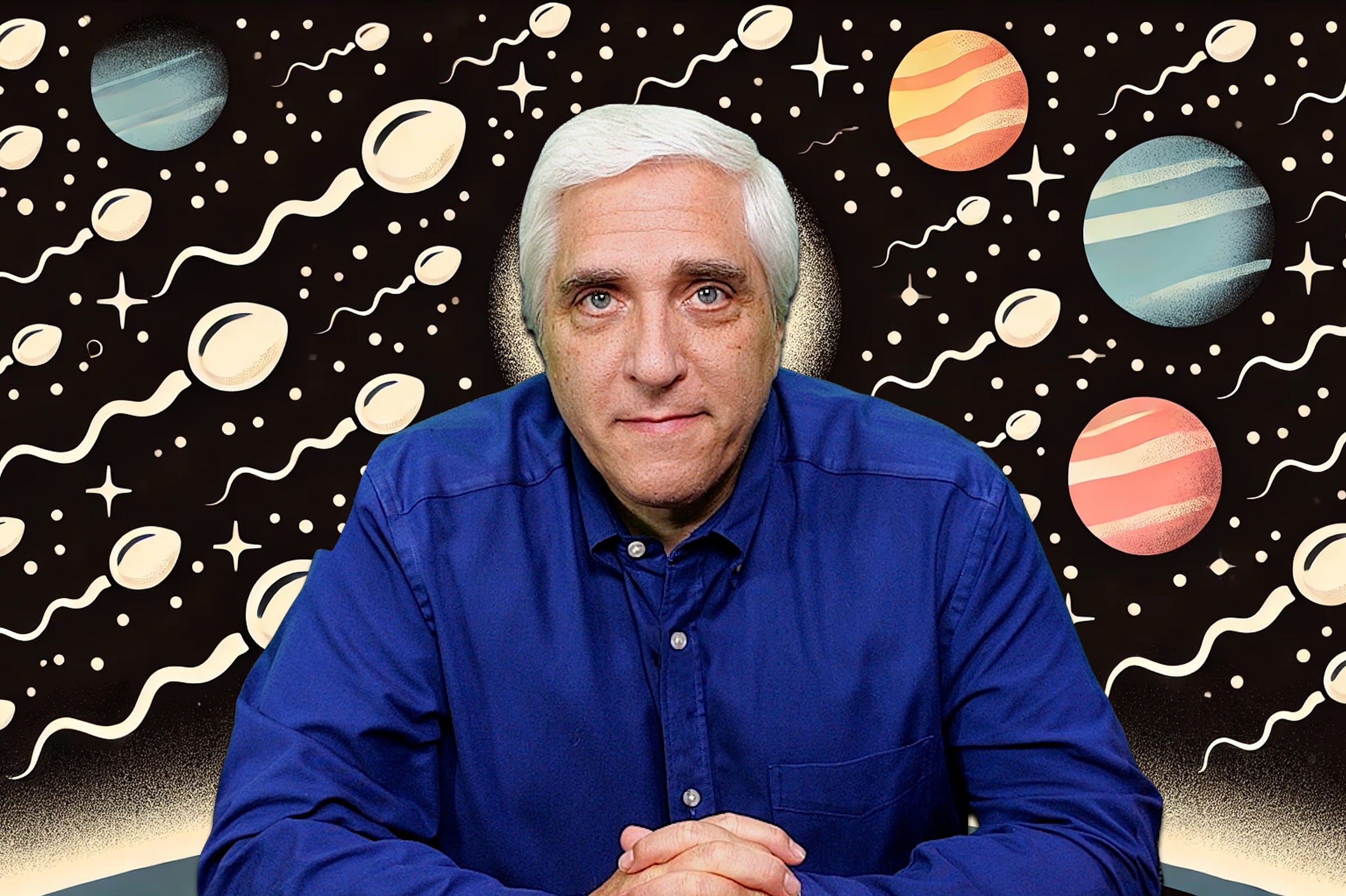






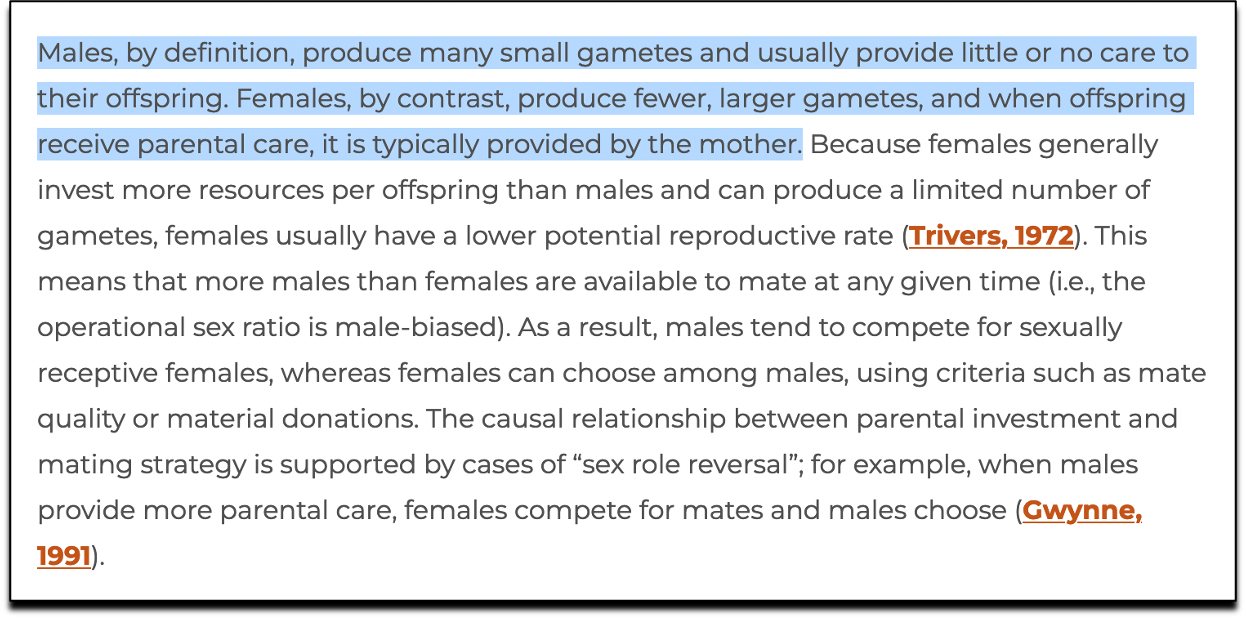




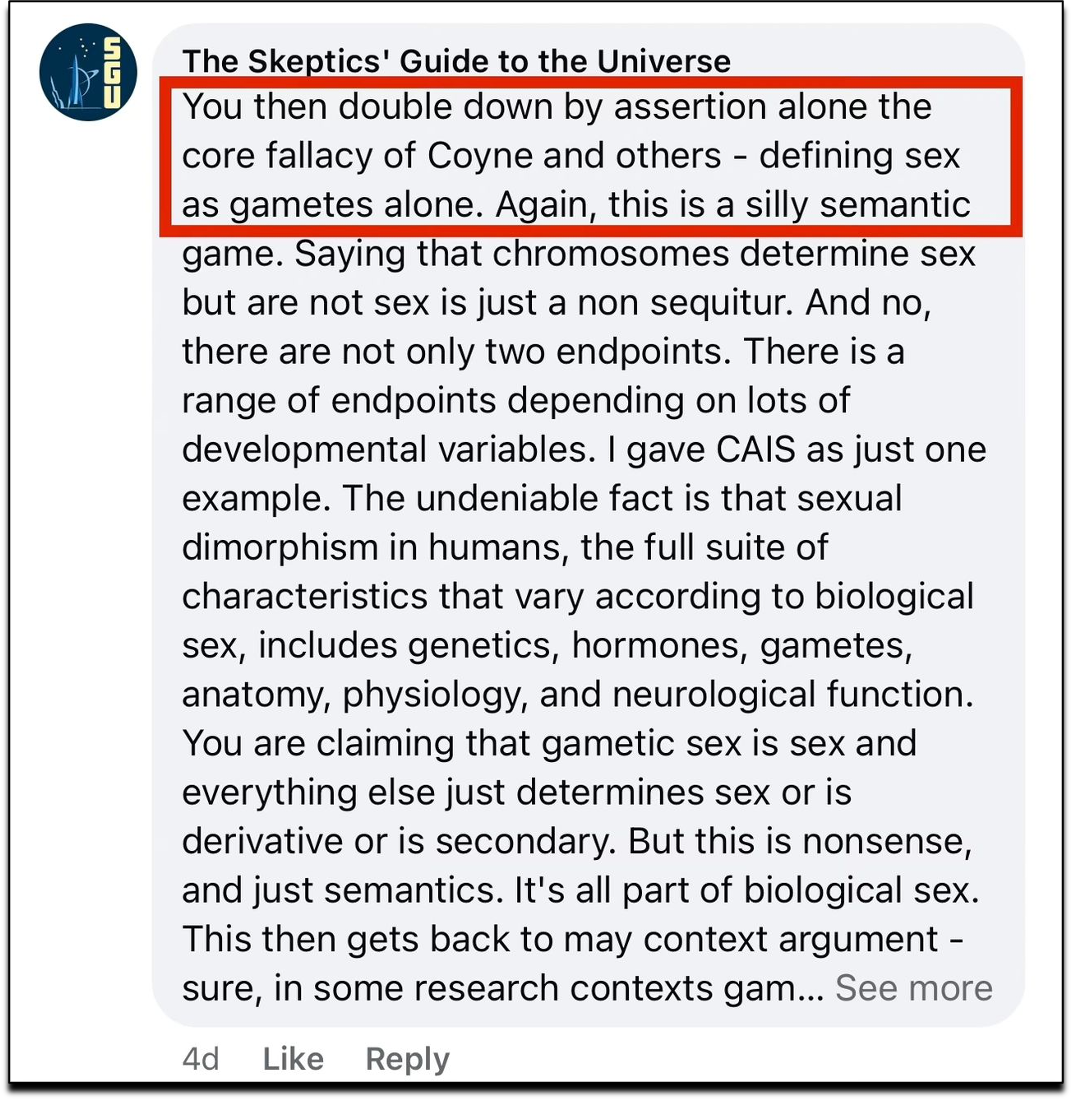








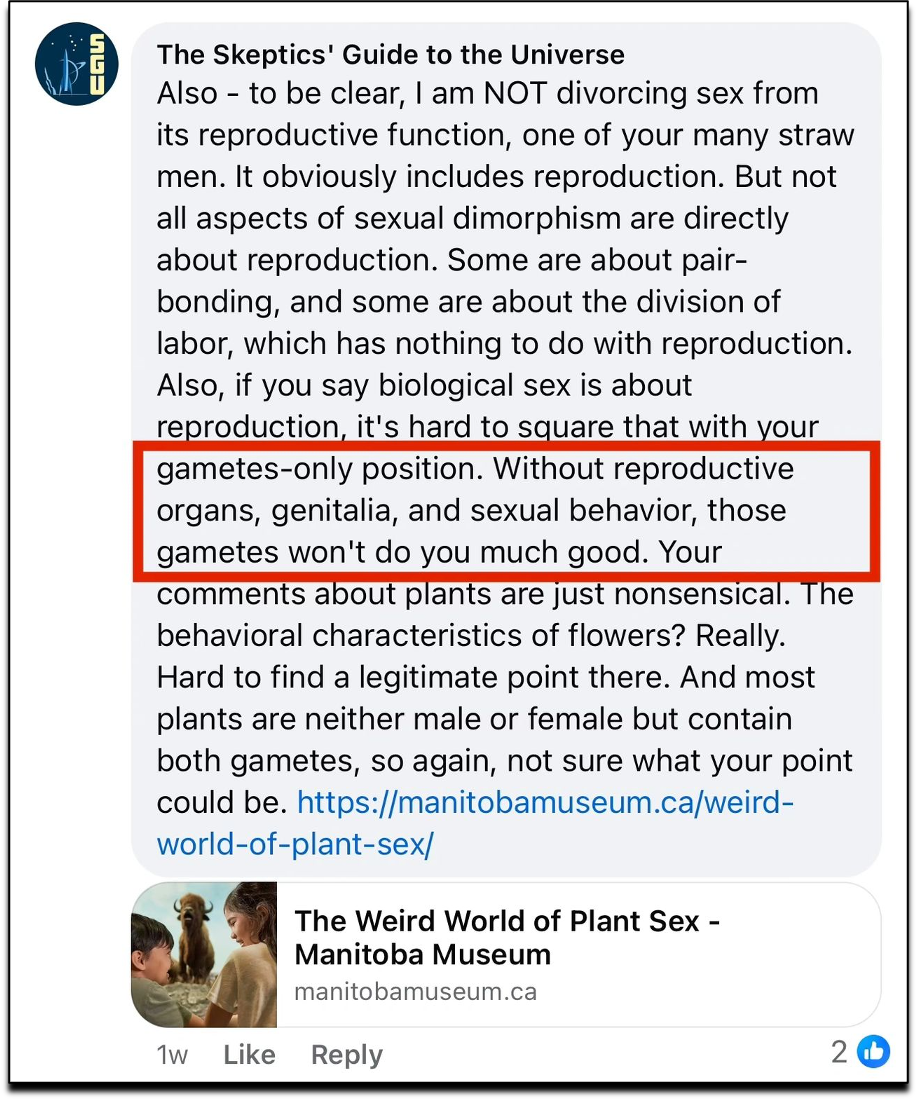





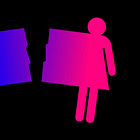




Thanks for the post! This is my first endeavor onto substack, and I’ve have a great introduction so far!
It appears the "spectrum" stance of physicist Neil DeGrasse-Tyson, which is sociological and not physiological, has been influence by a political censorship organization called Trans Journalists Association Style and Coverage Guide. This newly updated website now requests donations and has added further demands on the reporting of all things "trans." Doctors, scientists and researchers are kowtowing to intellectually stunted political hacks with a sexual fetish. I know their manipulative rituals--I divorced one. He now says he's me, mother of 2 sons.
https://www.youtube.com/watch?v=4VSwPvRZQYE&t=204s